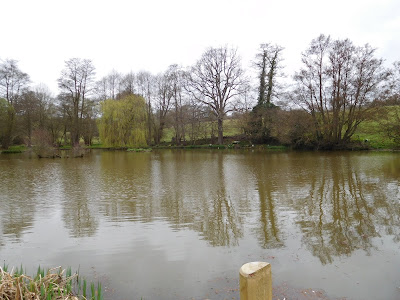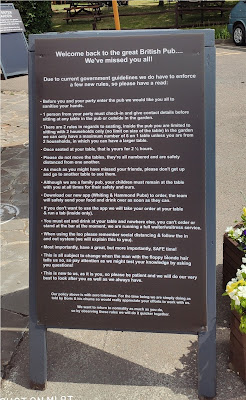Those breweries on home soil, include 20 established/ family
concerns and 15 micro-breweries. The latter ranging from “man in a shed” and
pub breweries, to some quite substantial operations – Dark Star, Woodfordes and
Hog’s Back. I haven’t included breweries visited, in order to collect beer for
parties or beer festivals; if I had names such as Boddingtons, Brakspear’s, Wethereds,
Palmers and Robinsons would feature on my list, even though the first three are no longer with us.
The overseas operations include 9 in mainland Europe, one in Ireland (Guinness naturally), and 7 in the United States. Apart from Guinness, there are some other “big boys” amongst this lot, including Carlsberg, Heineken, Pilsner Urquell and Stone Brewing (Richmond). I haven’t included the substantial number of brewpubs in Germany and the Czech Republic, where I have enjoyed beers brewed on the premises, but not viewed the actual brewing plant.
So, what exactly is the appeal of a brewery visit, and as some would day, once you’ve seen one, you’ve seen them all. Let’s answer the first one to begin with, and it does actually depend on the type of brewery it is. For example, there is far more to see at an established brewery such as Harvey’s, Elgood’s or Greene King.
These are family owned concerns with heritage and pedigree behind them. The same could be said of De Halve Maan in Bruges, their West Flanders neighbours Rodenbach, or Schumacher in Düsseldorf. All these places are fascinating combinations of old and new; factors which provide plenty of interest and lots of things to look at. Sadly other, traditional breweries such as Fremlin’s, Morland’s, Ridley’s and Young's are no longer with us, but at least I had the privilege of touring them whilst they were still brewing.
Of far less appeal are the ultra-modern mega-breweries, where everything is enclosed and there is little to catch one’s interest. The aforementioned “big boys” fall into this category, although Pilsner Urquell in Plzen, does at least mange to blend in some old plant with the new. Guinness, on the other hand, was a real disappointment with virtually nothing, apart from a collection of monstrous stainless-steel vessels and tanks to look at.
Some micro-breweries are also staggeringly boring to look
at, particularly if they are housed in a modern, look-alike, industrial unit.
If the premises are converted agricultural or industrial buildings, then this
is much better, especially if the premises have some character and pedigree associated with them.
That’s the first question put to bed, and it sort of answers the second by dismissing the absurd statement of having seen one, then you’ve seen them all. This quite clearly isn’t true, even though the process and mechanics of brewing are basically the same, despite the huge variances in size, construction and layout. In addition, as someone who was a keen home-brewer, a tour round a brewery provides insight into the brewing process and on occasion will give tips and ideas
Most brewery visits end with a sampling of the products, and some breweries are naturally far more generous than others. For some visitors this is the most interesting section of the tour, and for a handful, perhaps the sole reason for embarking on such a trip. Only real cynics, or out and out philistines would have such an attitude, but it does exist.
The end of tour enjoyment should be an opportunity for the brewery concerned to show off their wares and demonstrate the care and skill that has gone into creating each individual beer, and yet again some companies do this better than others. A charge that covers both the brewers, or their tour guides time is not unreasonable and especially so if the sampling room is generous. Some breweries will even include food as part of the package, and here a fee to cover this really should be expected.
Now some facts and figures about the 50+ brewery tours I have experienced over the past four and a half decades.
First brewery tour – Marston’s, Burton-on-Trent c. 1974.
Most recent tour, Cellar Head, Frant, 2019.
Best and most interesting tour(s) – Harvey’s, Lewes. I’ve undertaken at least four tours of Harvey’s, and possibly a fifth. Head Brewer, Miles Jenner has been the guide for all but one of these visits, and he is a real entertainer, as well as a font of knowledge of all things brewing. Last tour – April 2019.
Most unusual tour – Elgood’s, Wisbech c. late 1990’s. Elgood’s retain a classic, open wort cooler, known as a “cool ship” at the top of the brewery; similar to the one I viewed at De Halve Maan Brewery in Bruges.
This wasn’t the real surprise though, as after chatting to the head gardener, after looking round the brewery, I was given my own private tour of the four-acre, enclosed gardens behind the Georgian brewery buildings. The gardens were in the process of being restored to their former brewery and are now open to the public (not at present, due to Covid-19 restrictions).
Most missed brewery – Young’s, formerly of Wandsworth, London. A cask stalwart that stood firm against the keg-tide that threatened to engulf British brewing in the early 1970’s. Sorely missed, and only closed after former charismatic chairman John Young, had passed away.
Driest brewery tour - Hall & Woodhouse (Badger), Blandford Forum c. early 1990's. The family and I were staying in a rented, holiday
cottage, in a small village, about 5 miles outside Blandford. We'd called in at the brewery, earlier that day, and discovered a tour was taking place that evening. I was able to join the tour, but unfortunately had to drive myself there and back.The post-tour sampling was consequently very limited, although the company did provide me with a selection of bottles to take home.
 I'm sure you've probably got the picture now and, with luck, have realised that no matter how similar they might appear at first site, brewery tours are very much distinctive and different from each other. So, if you get the chance to join one, don't turn it down.
I'm sure you've probably got the picture now and, with luck, have realised that no matter how similar they might appear at first site, brewery tours are very much distinctive and different from each other. So, if you get the chance to join one, don't turn it down.










































